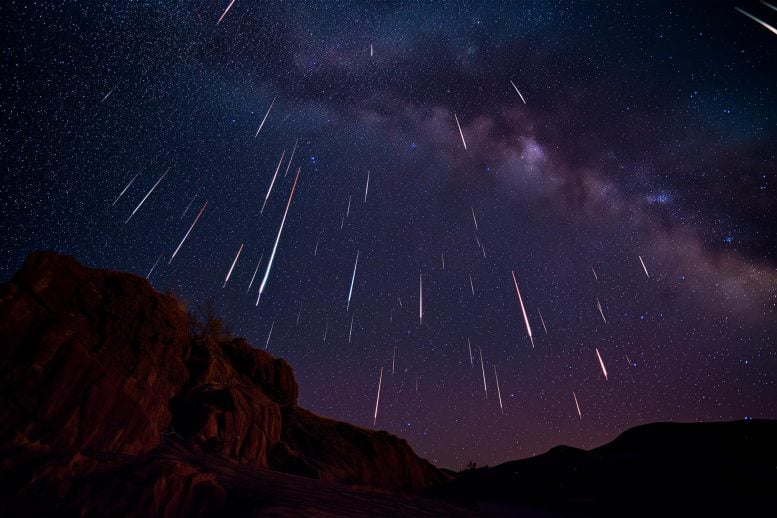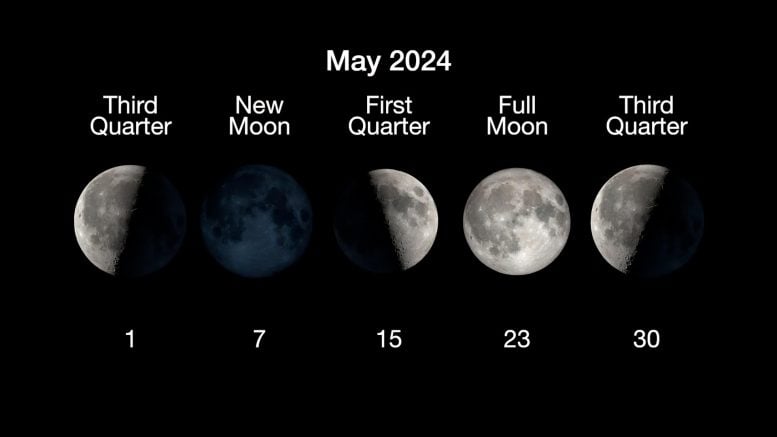
The Eta Aquariid Meteor Shower is a yearly event that happens from late April to mid-May, reaching its highest point around May 5th and 6th. It occurs when Earth moves through the debris left by Comet Halley, and the meteors seem to come from the Aquarius constellation. This shower is known for its fast and bright meteors, offering about 40 meteors per hour in ideal conditions in the Southern Hemisphere. Credit: SciTechDaily.com
What are some notable things to see in the sky in May 2024? Mars and Saturn interact with the Moon, Mercury makes a brief appearance in the morning, people on the East Coast can see the red giant star Antares come out from behind the Moon, and the eta Aquariid meteors reach their highest point on May 6th.
What to watch for:
Morning Meteors and May Planets
Observe Mars, Saturn, and Mercury in the sky in May mornings. Antares hides behind the Moon for skywatchers on the East Coast of the U.S. And the eta Aquariid meteors achieve their highest point on May 6th.
Video Transcript:
What’s Up for May? The Moon spends time with Saturn twice this month, the “heart” of the Scorpion disappears briefly, and there are morning meteors from Comet Halley.
On May 3rd, just before dawn, you can see the crescent Moon rising with Saturn in the morning twilight. Mars also rises about 45 minutes after Saturn, forming a nice lineup in the east for early risers to enjoy. Then, the next morning, the Moon shows a slimmer crescent and has moved between Saturn and Mars. The two planets are continuing to increase their separation following a close conjunction in early April, when they appeared very close in the sky.

Sky chart showing the Moon appearing very close to Saturn in the morning sky on May 31. Credit: NASA/JPL-Caltech
And if you have a clear view to the horizon, you might just see Mercury rising in the hour before the Sun. It’s quite bright, but it’s also low in the sky and competing with dawn twilight, so it's a good challenge. Those in the Southern Hemisphere will find it easier to spot Mercury, as it rises much higher in the sky for you.
On May 23rd, the full Moon will appear very close to the bright red star Antares, in Scorpius, as they rise. But for those on the East Coast of the U.S. – south of Delaware and down through the whole state of Florida – you’ll actually see the Moon pass in front of Antares – an event known as an occultation. Over a couple of hours as the pair rise into the night sky, the Moon will move slightly in its orbit, first covering and then revealing Antares. And finally, on May 31st, planet Saturn rises in the early hours of the morning with the crescent Moon in tow. If you’re up early on the last day of May, you’ll find the pair toward the southeast. They’ll be close enough to appear in the same field of view when viewed through binoculars.

Sky chart showing the radiant, or apparent point of origin, of the eta Aquariid meteor shower 2 hours before sunrise on May 6. Although all meteors seem to come from this area, they can actually appear anywhere in the sky. Credit: NASA/JPL-Caltech
Meteor Showers
Halley’s comet creates two annual meteor showers. In May, we see the eta Aquariid meteors, while the Orionid meteors appear in October. This happens because Earth goes through Comet Halley’s orbit twice each year. Along the comet's path is a meteor stream made up of small grains of rock and dust that burn up as meteors when they hit our atmosphere.
The meteor shower peaks during the night of May 5th and the morning of the 6th. However, you can see meteors from this shower throughout the week centered around the peak night. The radiant, where the meteors appear to come from, is in the constellation Aquarius. You can see meteors as long as the radiant is above the horizon, and there are more meteors the higher it is in the sky. Aquarius rises after midnight this time of year, so the best time to watch the shower is in the hours before dawn.
This is a great shower for observers in the Southern Hemisphere because the radiant rises higher in the sky before morning twilight due to longer nights in May, which is autumn there. Under optimal dark sky conditions, 40 meteors per hour can be seen. For Northern Hemisphere observers, it’s closer to 10 to 20 meteors per hour.
It's still an above-average shower, especially with the peak coinciding with a new moon, resulting in a darker sky. Also, the warmer springtime temperatures north of the equator make it a worthwhile shower to watch.
To see the most meteors, find a safe, dark spot away from bright lights and allow your eyes to adjust to the dark for a few minutes.
Lie down with your feet pointing toward the east, and look directly overhead. Take a warm drink and a couple of friends, and turn an early morning into a “meteor morning” as you search the skies for the eta Aquariid meteors.
Here are the Moon phases for May.

Sky chart displaying the Moon alongside Saturn and Mars before sunrise on May 3. Credit: NASA/JPL-Caltech



